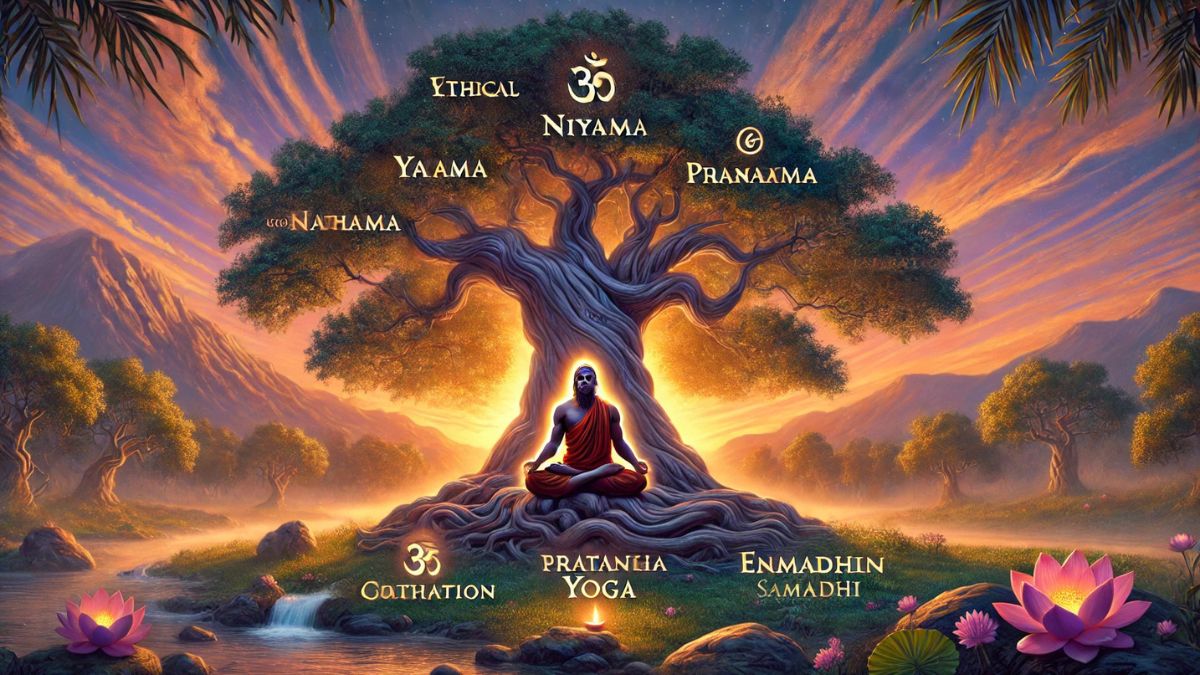Become a Mahayogi: Patanjali outlined eight steps to achieve self-discipline and spiritual growth. Each step is interdependent and gradually elevates the practitioner to higher consciousness.
Ashtanga Yoga: The Eightfold Path
Yama (Moral Restraints): Ethical disciplines to live harmoniously.
Ahimsa: Non-violence.
Satya: Truthfulness.
Asteya: Non-stealing.
Brahmacharya: Control of desires.
Aparigraha: Non-possessiveness.
Niyama (Self-Discipline): Personal practices for inner purification.
Shaucha: Cleanliness.
Santosh: Contentment.
Tapas: Discipline.
Swadhyaya: Study of scriptures and self.
Ishwarapranidhana: Surrender to God or higher consciousness.
Asana (Postures): Physical practices to develop a strong and flexible body.
Stability and comfort in sitting postures are essential for meditation.
Pranayama (Breath Control): Regulation of breath to harmonize the life force (prana).
Practices include inhalation, exhalation, and retention to calm the mind.
Pratyahara (Sense Withdrawal): Detachment of the senses from external stimuli.
Helps focus inward for mental clarity.
Dharana (Concentration): Focusing the mind on a single object or thought.
Strengthens mental discipline and prepares for meditation.
Dhyana (Meditation): Sustained focus on the inner self.
Leads to a calm, steady, and blissful state of being.
Samadhi (Absorption): Ultimate state of consciousness where the self merges with the infinite.
Experienced as blissful liberation (Kaivalya).

The Yoga Sutras
Structure: The Yoga Sutras contain 195 aphorisms (sutras) divided into four chapters:
Samadhi Pada: On contemplation and spiritual absorption.
Sadhana Pada: On practices to achieve self-discipline.
Vibhuti Pada: On supernatural powers and experiences.
Kaivalya Pada: On liberation and enlightenment.
Core Teaching: “Chitta Vritti Nirodha,” which means yoga is the cessation of mental modifications, allowing the practitioner to connect with their true self.
Five Kleshas (Afflictions)
Patanjali identifies obstacles that hinder spiritual progress:
Avidya: Ignorance.
Asmita: Egoism.
Raga: Attachment.
Dvesha: Aversion.
Abhinivesha: Fear of death.
Overcoming these kleshas is vital for achieving liberation.

Practical Benefits of Patanjali Yoga Vidya:
Physical Health: Enhances flexibility, strength, and stamina.
Mental Peace: Calms the mind and reduces stress and anxiety.
Emotional Balance: Promotes self-awareness and emotional stability.
Spiritual Growth: Encourages introspection and connection to the divine.
Relevance of Patanjali Yoga Vidya Today
Modern yoga practices often draw from Patanjali’s teachings. While asanas and pranayama are widely practiced, incorporating ethical and meditative practices offers a more holistic approach to well-being.
Key Resources:
To explore further:
Books: “Yoga Sutras of Patanjali” with commentaries by scholars like Swami Vivekananda or B.K.S. Iyengar.
Practices: Begin with simple Yamas, Niyamas, and meditation to build a foundation in Patanjali’s Yoga Vidya.
Another like this- Devraha Baba was discribe the importance of Mahakumbh
